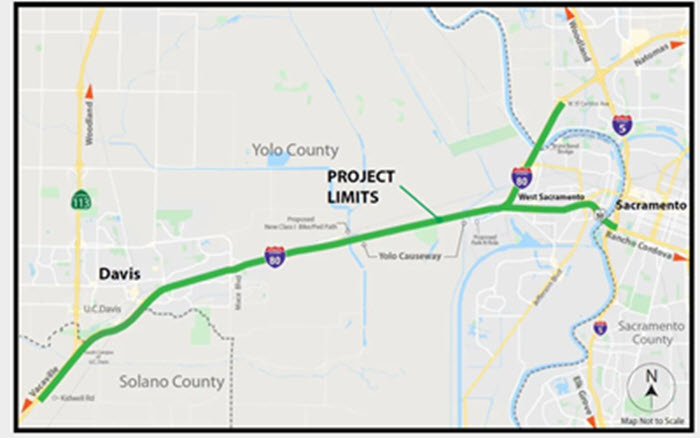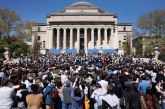

YoloTD cannot produce a financial forecast for $465m/project
By Alan Hirsch
On Tuesday, March 5 the Davis City Council will review and hopefully reverse the current city policy that endorses I-80 freeway widening for cars.
(Note the date of the I-80 council item was originally Feb 20, but was changed on Friday at 5 pm)
If the current council does not reverse this it is an effective rejection of the city’s climate action plan, a rejection of research at UC Davis, and a rejection of the State and even the Caltrans Climate Action Plan. Councilmember Will Arnold, the former Caltrans Director of Media Relations, shared Caltrans policy at the January 9, 2024, council meeting which he summarized: believing freeway widening will fix anything is the definition of insanity. (Link to  transcript of Arnold’s remarks)
transcript of Arnold’s remarks)
Davis policy set by the closed door subcommittee.
The pro-freeway city policy surfaced recently in the form of a letter City Manager Mike Webb wrote to the Federal Highway Administration “strongly endorsing” the car-widening project. He wrote this in March 2021 based on two lines buried in a 10-page “Legislative Lobbying Policy” document passed by the council on February 16, 2021. The city has confirmed to me by email that the I-80 policy was done with no review by the BTSSC transportation commission and the Council was never agenized for discussion focused only on I-80 previous to this. It is rather strange that the “Leg” committee (Lucas/Carson) should develop policy on matters so integral to transportation, planning and climate change.
That this policy was done quietly may have been to avoid surface controversy: opposition to the widening was already widespread in 2021 as indicated in the minutes of the July 8, 2021, BTSSC meeting when Caltrans made its first—and only—presentation to that body.
This means the March 5, 2024, meeting will be the first chance to bring policy making into the light of day.
Every-changing justification for I-80 widening
I-80 widening advocates have shifted their arguments to find support now that it has come before council for debate. There have now been two council meetings where 20+ people have shown up in opposition to the widening (June 6 and Jan 9). This demonstrating the transportation science out of UC Davis on induced demand is well known—and the initial argument that “widening the freeway will fix congestion” is only believed by a minority in the city, especially after the Dec 7 Pro/Con Teach in. Even the SacBee has noted the fact the DEIR is obviously wrong in its traffic modeling as it neglected induced demand.
Davis Freeway Proponents, which primarily means Davis Mayor Josh Chapman, then pivoted to arguing we might as well widen the freeway as we have an $86 million grant from congress that can only be used for a car lane.
This argument has subsequently been overturned by observation that $86 million is only a down payment: Yolo County still has to lobby for the missing $200M to $300 million to finish the highway project—and this means this new money, if used for I-80, won’t then be available for transit improvements.
Now freeway proponents have pivoted yet again, arguing the toll lane will fund better transit: “Yeah, widening the freeway is bad but we must do it in order for us to get better transit.”
The problem with that argument is twofold:
- The toll revenue generated by new lane forecast to be about $10 million/year is woefully short of that is needed to mitigate the new GHG/VMT (vehicle miles traveled) generated by the new lane.
- Treating improved transit for Yolo County as a mitigation—i.e. a carbon offset for the wider freeway’s induce traffic means the plan is actually boiling down to this: Get more Davisites to ride the bus or train in order to make it ok, (offset) more driving by Solano, Sacramento and Tahoe traffic induced by the new lane.
How is that fair and equitable?
No financial forecast to fund the mitigation.
I have been in a running dialogue with Yolo Planning director Brian Abbanat for three weeks now; he has confirmed that no financial projections exist for the project of how toll revenue is generated compared to the on-going need to mitigate the GHG/VMT. i.e. by providing better transit to voluntarily entice Davisites and others into bus and rail.
While there are estimates that the toll lane (HOT3+) will generate just short of /$10 M/year (in 2049), this revenue falls far short of the cost of mitigation of the 180m VMT/yr the project will generate—and even short of what is needed of DEIR’s smaller mitigation plan of 1/3 of the 180M-57m VMT/year.
How much it will cost to mitigate 57m VMT/year is strangely never stated in the DEIR (page 2-124 thru-2-126) but it is likely over $50mil/year—5x the toll revenue. The cost of providing microtransit service is $7 a passenger mile or more, and the public subsidy for Yolobus service is $0.90-1.30/passenger mile. (This excluding capital cost), So clearly the cost of an enhanced transit to carry 57VMT/ a year is clearly over $57M /year.
Abbanat has written to me to suggest, in lieu of a total financial plan provided in DEIR( !!!) He has done a back-of-the-envelope analysis—the mitigation plan for 57M/mile VMT and only will require $13mil a year. But that is only 23c/ VMT — 1/5 the cost of Yolobus providing bus service per passenger mile, and 1/30 their cost of providing microtransit. Brian’s back of the envelope makes no sense. Confirming YoloTD has no mitigation financial plan.
And again, remember, 57M mile is just 1/3 of the total project 180 m VMT/GHG the wider freeway creates each year.
So, where will these missing tens of millions of dollars a year come from? $50million/yr is a big number: YoloTD’s budget is only about $13 million per year. It is unclear, but the bottom line is once the freeway is widened Yolo County is on the hook to fund the mitigation, as Caltrans Greg Wong stated at the Dec 11, 2023, Yolo TD meeting.
It remains strange Caltrans DEIR mitigation plan does not provide a total cost for doing it—much less explain how it will be funded beyond the initial one-time funding of $55 Mil in the capital plan. But maybe that is the game: Caltrans builds the freeway and leaves the bill for VMT mitigation with Yolo County residents.
* * **
Check my Math: The I-80 mitigation plan can be found on pages 2-123—2-126 in the DEIR or summarized in slides 15- 20 at 12/11/23 Yolo TD meeting agenda packet. The operating cost to provide transit service on a per passenger mile basis (equal to VMT mitigation cost) for providing fix route bus or on-demand microtransit service can be found for different transportation agencies, including YoloBus here.






I hope the “Pro-bottleneck “ forces don’t prevail. I am curious what environmental impact the status quo would be. As Covid mitigation’s lift, more workers will be heading back to Sacramento each day. So in fact the traffic gridlock is poised to border on catastrophic. Be ready for a half hour trip to Sacramento to take an hour or more. And as traffic apps divert drivers on to our surface streets, be ready for a 5 minute trip to downtown to take triple the time or more. Or take a bike and enjoy the fumes as the exhaust of thousands of idling autos wait impatiently through multiple traffic light cycles and run engines in a bumper to bumper stand still on I-80. And God forbid if you need ambulance transport to UC Davis Med Center ;our nearest trauma center. I guess it’s “hello Life Flight “. My first years in Davis there were 2 lanes in each direction across the Causeway. Things changed and infrastructure was adjusted. A 4th lane is at least a stopgap measure until transit is improved.
Even beefed up public/mass transit will never take the place of additional lanes on I-80. Not enough people will use it by a long shot. Most people don’t even consider using mass transit for a variety of reasons. They instinctively use I-80. I know that both I and everyone else I know do. Looking at you false environmentalists.
To actually take the place of additional freeway lanes would require an investment in the billions of dollars. A new dedicated Amtrak rail line completely separate from freight rail service would be required running from Auburn straight into San Francisco. New much faster trains are also sorely needed. The current ones crawl. The current state of affairs is really a sad joke.